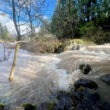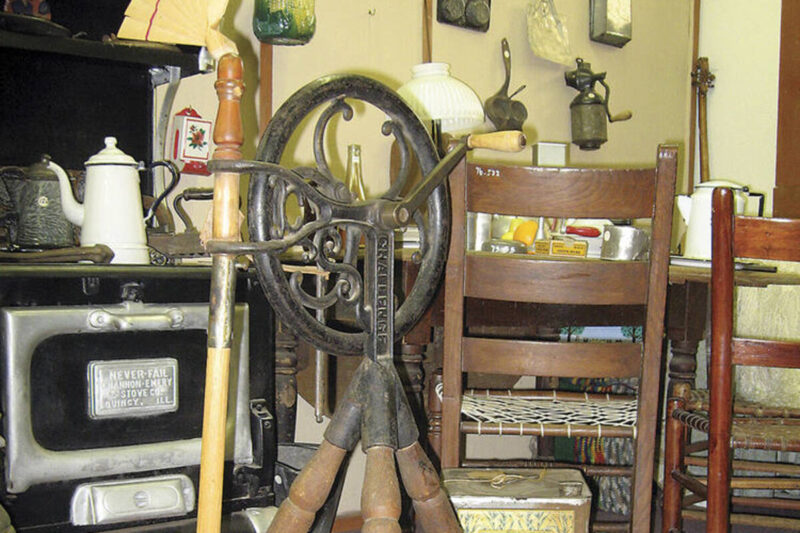Roberta McKern
We hear the phrase “The more things change, the more they stay the same,” and often we nod and echo, “Yes, yes.”
Should we? Likely not.
Things do not hold steady and unchanged, as we can easily tell when we visit the East Linn Museum. While we wander through, if we pause to wonder, it’s readily apparent much has changed regarding what we see around us. Take a little brochure entitled “The Truth About a Lye.” Considering the spelling, l-y-e, we can realize it will be a caustic truth.
The lye in question was Lewis Lye, a product of the Pennsylvania Salt Manufacturing Company of Philadelphia. At a price of 15 cents, the booklet proved useful enough to go through repeated printings from 1904 to at least 1930.
We can assume Lewis Lye had been around for years earlier because the company had a founding date of 1850. For awhile then, Lewis Lye had been on hand to aid housewives, farmers, stock raisers and others with their various chores.
Indeed, Lewis Lye could be concocted into numerous solutions when added to water in differing quantities. It acted as a cleaning agent, a disinfectant, an ingredient in a sheep dip or a treatment for Fido’s mange, as a means of preparing plums for drying into prunes, and in making hominy, among assorted uses.
Today most of us associate lye with unclogging household drains. In the past, it had a nasty reputation for ending failed romances when a jilted Romeo would fling lye in the face of fickle Juliet to disfigure her and make sure no other would love her as he had.
This image sticks in the mind, underlying the fact that lye is not the safest chemical to be found in a household.
Lye can be either sodium hydroxide or potassium hydroxide. It bonds strongly with water, causing heat and corrosive action.
We may buy products using lye, but it is certainly not as ubiquitous in households as it was during Lewis Lye’s heyday when, as its manufacturers insisted, it made really, really good homemade soap, soap just as good as that produced by the big Chicago plants.
Not only was this so, but homemakers who made their own soap, using Lewis Lye of course, could save money to purchase items closer to their heart’s desire, while at the same time they used something which they might simply have thrown away: lard, tallow and grease left over from cooking.
Some of us may remember chunks of homemade soap produced by an intrepid relative using lye made by running water through wood ashes, particularly ashes from oak firewood. The soap appeared strong enough to wash a logger’s stagged pants. It was not the kind a kid wanted to encounter when being punished for lying or using words OK for adult males but not children.
It certainly seemed cleansing.
Forget the wood ashes, however. Such soap could not have lived up to Lewis Lye’s standards.
Here is Lewis Lye’s basic recipe for making hard soap with two fast rules: Never pour the liquid used – in this case, clear fat – into the lye, and never use an aluminum container. They don’t specify what happens with an aluminum container, but apparently it is not good.
This is merely an example recipe so don’t try it: Empty one can of Lewis Lye (13 ounces) into a stone jar (ceramic vessel?) or an iron one containing 2 1/2 pints of cold water. Stir until the lye has dissolved. Cool to 70° F.
Melt six pounds of lard, grease, or drippings which are clear and salt free and bring the temperature up to 100° F. Add the lye solution to the grease (this is in heavy, black type on their part) in a small steady stream with slow, even stirring.
Adding the lye too fast or stirring too rambunctiously will cause separation of the product. Continue stirring for about 10 minutes or until the mixture has a thick, syrupy consistency. Then pour it into a mold.
A wooden tray lined with oiled paper or cheesecloth is suggested as is covering the mold with a blanket or carpet before setting it in a warm room. Twenty-four hours later, the soap should be removable from the mold, ready to cut into pieces.
Presumably, farm wives with thermometers in hand, followed these directions to make laundry soap. They could go further and gussie it up by using oils like castor, coconut, cotton, fish and olive oils. Glycerine, too, could go into a batch but glycerine should not be used close to a fire – think nitro-glycerine!
If the soap maker wanted to manufacture a product that would float, the batch simply had to be whipped while still soft. And there was also the option of adding perfume.
Indeed, following the Lewis Lye instructions, a 1906 housewife could go to the Sears Roebuck catalog and compare her home made product with those fancier soaps Sears offered. She could also see how much money she may have saved while reading the nearby ad for Lewis Lye. (Actually, it was the most expensive lye in the catalog at $1.05 for a dozen 13-ounce cans.)
So, what did all of this soap making lead to? Washday Monday.
The East Linn Museum has a pretty good display of the utensils used when Monday piles of laundry accumulated.
As she stared at those piles of blue denims, this could be a stressful blue Monday for the housewife, the blue not really having to do with Mrs. Stewart’s Bluing – a bottle of which sits on an early washing machine in the museum display. Blueing (Mrs. Stewart’s leaves out the e) was supposed to make dull whites look whiter.
In times past, wash days often also put a stress on education when older sons and daughters were required to stay home to help Mother handle wood for the fire and water for the copper boiler sitting on the cookstove in front of a pot of beans simmering along with two pieces of bacon, two, neither less nor more.
Beans and Monday washdays paired together.
Neither Lewis Lye homemade soap nor the pot of beans appear in the museum’s laundry corner, but along with a copper boiler, there are big wash tubs, scrub boards, hand-operated wringers and a progression of washing machines. The earlier ones include a cradle-like apparatus with an inner frame that moved back and forth to rock the wash in the tub and a barrel-shaped one with a gear system on top turned by a lever which moved an agitator inside, thus stirring the wash.
Both machines benefited from being operated by a hefty adolescent would-be baseball pitcher intent on strengthening his arm for a curve ball pitch. He could also operate the attached wringer.
Two early electric washers likely improved someone’s wash days. One is an impressive Syracuse “Easy” machine with a fantastic futuristic agitator.
No doubt for many housewives doing laundry made Mondays tedious. At the same time, taking in laundry served as a way for women to earn extra needed money for their families.
This often was the case, especially for widows and other households headed by women. The tools needed were already on hand, a copper boiler, wash tubs, scrub board and hand cranked wringer. As Lewis Lye would argue, homemade soap was cheap. And washing clothes didn’t call for the same level of skills needed for a lady to set herself up as a millinery, seamstress or carpet weaver. From his book “Profiles of Progress,” we know Roy Elliot helped his grandmother Nancy Donaca when she thriftily took in wash, working for others.
With washday Mondays, at least for a moment the week started cleaner and nearer to godliness.
People do make soap today. It is kind of harkening back to an earlier craft. However, lye certainly isn’t as common in the marketplace as it used to be.
Handmade soaps encountered at craft markets often strike us as being gift soaps, not something we’d stop to carve up to get flakes for an automatic washer.
The laundry soaps we run into appear to be chemical concoctions beyond ordinary understanding, but like Lewis Lye soaps, they are out there to keep us pure and clean and protected from diseases and infections.
We don’t have a need to set up a big iron rendering kettle in the side yard over a hot wood fire and filled with boiling water and strong homemade lye soap to purify winter woolens and long underwear when spring finally comes.
There is a big gap between what doing the wash on Monday used to be and what it is now, and it is unlikely we will complain about it.
Sometimes it takes little booklets like “The Truth About a Lye” and displays like that of the laundry section in the East Linn Museum to remind us of how much things have changed and for the better.
At the museum we are awaiting spring while we are still closed until the first Thursday in March – or until museums are allowed to reopen in the current situation.
Maybe a little Lewis Lye soap would help us with our healthful hand washing! We hope for better things ahead and good health for all of us.





